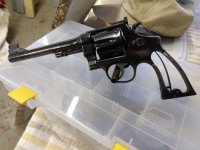Hi Guys,
I have been looking into the King Gun Sight Co, and other related shops, such as Micro Sight Co, in my interest in mid 20th century Bullseye revolver custom work, specifically as carried out on the wonderful K and N frame S&W revolvers we all know and love.
While the products and services offered by King are fairly well documented in all their variations and glory, few are aware that there were other competing firms. One of these was the Micro Sight Co., which was incorporated on April 24, 1947 (supposedly by one or more former King employees!).
No doubt many of you are aware of Micro as being the makers of the rear sight used on many of the Old Model Ruger Blackhawks. (How brilliant of Bill Ruger. He was basically offering what amounted to a custom revolver with everything many folks dreamed of!)
However, Micro did a lot of custom work on revolvers, as well! This work included installing their own design of click adjustable rear sights, ramped front sights with Baughmann or Patridge profiles, action work, and customizing hammers to "cockeye" configuration.
As it turns out, it was the latter work that got them into hot water, legally speaking. A lawsuit was filed in the U.S. Court of Appeals for the Ninth Circuit by King against Micro in January 1955. The lawsuit had four points, but mainly claimed of copyright infringement of the term "Cockeyed" hammer. One other significant claim of the suit was unfair competition. It was claimed that an employee of King's was also in the employ of Micro, and was diverting business from the former to the latter, specifically involving the fabrication and installation of cockeyed hammers.
However, the point likely of most interest to S&W aficionados and collectors is probably that of the "Cockeyed" hammer trademark and patent. King's claimed ownership of both, through U.S. Pat. #2,159,527 and a Jan 11, 1938 trademark certificate of registration #353691.
Legal representatives of Micro argued that the development of the cockeyed hammer could actually be traced back earlier to a Diefendorf-O'Toole innovation going back to 1935. In the course of the trial, other patent drawings, two going back to the late 19th century, were produced that pre-dated the King patent.
Micro prevailed in court on three of the four counts, and furthermore, the court ruled both King's patent and trademark registration as invalid.
The court also ruled that each party was responsible to bear their own legal costs.
Lawsuits of this type were surprisingly common at this time amongst partnerships and competitors in the gunsmithing world. Think of the time and money this must have diverted from their businesses.
On this point, I guess this might be a contributing factor in why both King and Micro eventually just quietly went away.
I hope this is of some interest....
Best Regards,
Jim
PS: You can read the court records by searching sites like law.justia.com and openjurist.org
I have been looking into the King Gun Sight Co, and other related shops, such as Micro Sight Co, in my interest in mid 20th century Bullseye revolver custom work, specifically as carried out on the wonderful K and N frame S&W revolvers we all know and love.
While the products and services offered by King are fairly well documented in all their variations and glory, few are aware that there were other competing firms. One of these was the Micro Sight Co., which was incorporated on April 24, 1947 (supposedly by one or more former King employees!).
No doubt many of you are aware of Micro as being the makers of the rear sight used on many of the Old Model Ruger Blackhawks. (How brilliant of Bill Ruger. He was basically offering what amounted to a custom revolver with everything many folks dreamed of!)
However, Micro did a lot of custom work on revolvers, as well! This work included installing their own design of click adjustable rear sights, ramped front sights with Baughmann or Patridge profiles, action work, and customizing hammers to "cockeye" configuration.
As it turns out, it was the latter work that got them into hot water, legally speaking. A lawsuit was filed in the U.S. Court of Appeals for the Ninth Circuit by King against Micro in January 1955. The lawsuit had four points, but mainly claimed of copyright infringement of the term "Cockeyed" hammer. One other significant claim of the suit was unfair competition. It was claimed that an employee of King's was also in the employ of Micro, and was diverting business from the former to the latter, specifically involving the fabrication and installation of cockeyed hammers.
However, the point likely of most interest to S&W aficionados and collectors is probably that of the "Cockeyed" hammer trademark and patent. King's claimed ownership of both, through U.S. Pat. #2,159,527 and a Jan 11, 1938 trademark certificate of registration #353691.
Legal representatives of Micro argued that the development of the cockeyed hammer could actually be traced back earlier to a Diefendorf-O'Toole innovation going back to 1935. In the course of the trial, other patent drawings, two going back to the late 19th century, were produced that pre-dated the King patent.
Micro prevailed in court on three of the four counts, and furthermore, the court ruled both King's patent and trademark registration as invalid.
The court also ruled that each party was responsible to bear their own legal costs.
Lawsuits of this type were surprisingly common at this time amongst partnerships and competitors in the gunsmithing world. Think of the time and money this must have diverted from their businesses.
On this point, I guess this might be a contributing factor in why both King and Micro eventually just quietly went away.
I hope this is of some interest....
Best Regards,
Jim
PS: You can read the court records by searching sites like law.justia.com and openjurist.org
Last edited:









